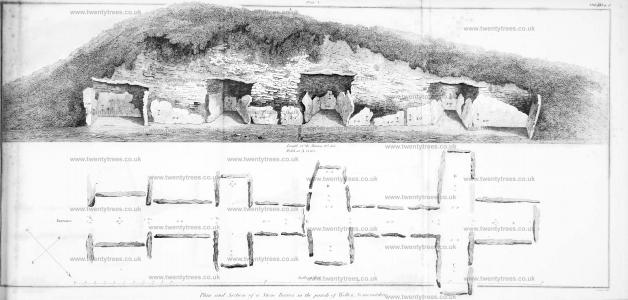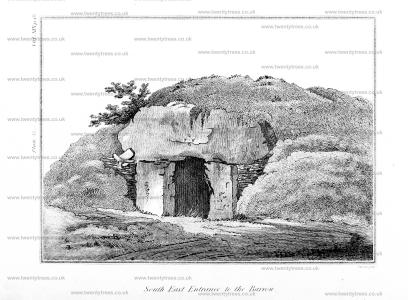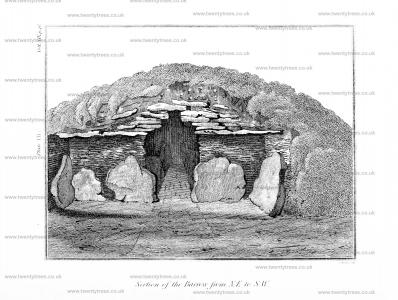Archaeologia Volume 19 Section IV
Archaeologia Volume 19 Section IV is in Archaeologia Volume 19.
1816. An Account of a Stone Barrow [Map], in the Parish of Wellow, at Stoney Littleton [Map] in the County of Somerset, which was opened and investigated in the Month of May 1816. Communicated by Sir Richard Colt Hoare (age 57), Bart. F.S.A. Read 22d May, 1817.

In my introduction to the Ancient History of South Wiltshire, I have endeavoured to investigate with accuracy and minuteness, the various barrows with which our chalk hills particularly abound. I have stated their forms, construction, and contents. Those which occur most frequently, may be divided into four classes. I. The long barrow. II. The bowl-shaped barrow. III. The bell-shaped barrow. IV. The Druid barrow. The two first, from the general simplicity of their structure, appear to be the most ancient; for in N° 3 we find a great degree of symmetry in the design, which corresponds with the figure of a bell: and N° 4 varies materially from all the preceding. I know not from what circumstances the learned Dr. Stukeley appropriated these low tumuli to the British order of Priests called Druids; I am rather inclined to think, from the result of our own researches, that they were destined to receive the bones and the ashes of the female tribe of Britons; for the articles generally found within them, both with regard to size and quality, have been such as were more becoming to a lady than a priest. But the most inexplicable of all the barrows, and the most distinguished by its size and construction, is the Long Barrow, consisting of an immense long ridge of earth, pointing most frequently from East to West; and rising to a higher degree of elevation towards the former aspect. These are the barrows which the Northern Writers describe as ship barrows — carincæ instar.
In endeavouring to investigate and develop the history of these great efforts of human art, much time and expense have been lavished, and I fear, without much profit or information. We have invariably found the sepulchral deposit placed under the East, or most distinguished end of the tumulus; and the interments to consist of skeletons buried in an irregular and promiscuous manner, and unaccompanied by those fine urns, gilt daggers, &c. which have rewarded our labours in the bowl and bell-shaped barrows. From these circumstances we might be led to suppose that they had been raised over the bodies of the lower class of people; but can we suppose that the British tribes would have raised such immense mounds for this purpose?
A false idea has prevailed respecting the sepulchral mounds which we see so thickly dispersed over the chalky hills in Wiltshire and Dorset. They have been called battle barrows, as if raised over the bodies of the Britons who were slain in battle. The barrow, in my opinion, was a grave of honour, raised over the ashes of the chieftain, not of the vassal, whose remains were deposited in the parent earth, without the distinguishing mark of an elevated mound. I am inclined to form this conjecture, from the frequent discoveries made on our bare downs of skeletons, sine tumulo, and many of our large barrows, have been found to contain the bones or ashes of one single corpse. Still, however, the verdant mound raised over the body of the deceased, whether interred toto corpore, or reduced to ashes by cremation, appears from uncontested evidence, to have been the most ancient and simple mode of burial; and whether we consider the sepulchral mounds on the shores of the Hellespont, & c. or compare the gigantic tumuli at Abury and Marden with the humble grave in our English church-yards, still we may adopt in their descriptions, the words of Tacitus, Sepulchrum cespes erigit. [Google Translate "He raises the grave grass"]
A new species of tumulus now excites my attention, which I shall denominate the Stone Barrow, varying from the Long Barrow; not in its external, but in its internal mode of construction. None of this kind occurred to me during my researches in South Wiltshire; for the material of stone with which they were partly formed was wanting. But some I have found in North Wiltshire, and will be described in my ancient history of that district. I have met with some specimens both in Ireland and in Anglesey, but none corresponding in plan, or more perfect in its construction, than the one which I have now the honour to submit to the consideration of my brother Antiquaries.
The first sight I had of this barrow was at a time when Colonel Leigh of Combe Hay had ordered a Roman pavement to be uncovered at Wellow, in the year 1807, for the satisfaction of his friends and the curious in Antiquities.a It was then pointed out to me at some distance from the spot on which we were engaged with the Romans; and Colonel Leigh, in the most obliging manner, offered to have it opened whenever I could attend. But various other antiquarian researches attracted my attention till the year 1816, when my friend Mr. Skinner, the Rector of the adjoining parish of Camerton, kindly offered to undertake and superintend the necessary operations.
Note a. I was present at the uncovering of this fine mosaic pavement, and saw with astonishment an engraving made from it, at the period of its first discovery, which differed so totally from the original, that I could almost fancy it had been done from memory.
Under his judicious and able guidance, an opening was made in the roof, and the whole of the passage cleared of its rubbish; and he had the satisfaction to find that the interior had suffered very little by the lapse of time, having experienced only one inconsiderable fracture in the roof, which being enlarged, served as our adit on this occasion.
This singular burying place is of an oblong form, measuring 107 feet in length, 54 feet in extreme width over the barrow, and 13 feet in height. [Pl. I.] It stands on the side of a sloping field, called "Round Hill Tyning" about three quarters of a mile to the S. W. of Wellow church, and nearly the same distance to the South of Wellow Hays (the field in which is the Roman pavement), and a short half mile from Stoney Littleton house. The entrance to this tumulus faces the North West: a large stone upwards of seven feet long and three and a half wide, supported by two others, forms the lintern over a square aperture about four feet high, which had been closed, by a large stone, apparently for many years. [Pl. II.] This was removed in my presence, and the original entrance restored. It then discovered to us a long and narrow passage or avenue, extending in length forty-seven feet six inches, and varying in its breadth. The straight line is broken, if I may use the modern expression, by three transepts, forming as many recesses on each side of the avenue. These correspond only in their relative situation, as being placed opposite to each other; not in the uniformity of their construction, as will be seen by the annexed section. [Pl. I.] The side walls are formed of thin laminae of stone piled closely together without cement, and a rude kind of arched roof is made by stones so placed as to overlap each other. Where the large stones in the side walls did not join, the interstices were filled up with layers of small stones, as described in Pl. III.



After a lapse of so many centuries since the probable formation of this sepulchre, our antiquarian zeal could not be carried to such a pitch, as to lead us to the expectation of making any new or perfect discovery; and indeed we were informed, by the neighbouring inhabitants, that it had been resorted to as a stone quarry by a farmer, and as a hiding place by a fox, who had taken shelter there, but in vain. Our investigation fully proved, that the interments had been disturbed, and their deposits probably removed; for, in the long avenue, we met with many fragments of bones, &c. which had probably been removed from the sepulchral recesses; many of which had been filled up with stones, and other rubbish. In the furthermost recess at A. were leg and thigh bones, with smaller fragments. At B. there were confused heaps of bones and earth. At C. four jaw-bones were found, the teeth perfect; also the upper part of two crania, which appeared to us remarkably flat in the forehead: there were also several leg, thigh, and arm bones, with vertebræ, but no perfect skeleton. This cell had been less disturbed than the others, owing to one of the side stones having fallen down across the entrance. In the cist D. were fragments of an earthen vessel, with burned bones; also a number of bones, which from their variety seemed to have been the relics of two or three skeletons. At E. there is a stone placed across the passage, for which I cannot well account, except we suppose that the sepulchral vault extended at first only thus far; and in later times was enlarged to the present extent.
I have had occasion to remark in former publications, that the Long Barrow, in its local disposition, was generally directed from East to West, and that the broadest end was inclined towards the former point; but in this tumulus now under consideration, there is a variety in its position, which bears nearly North East and South West, and has its broadest point towards the South East.
By the annexed Sketches, which I have the honour to lay before the Society, it will appear, that a certain rude uniformity has been observed in the general plan; and that each side of the vault corresponds in the number of its recesses: but these vary in their dimensions, and no attention has been paid to the size or symmetry of the stones which line the sides, and which are placed in the same rude state as when extracted from the quarry, and at a period, probably, when the use of tools was unknown. The remains of bones, and fragments of pottery dispersed about this barrow, prove that the two systems of burial were here adopted; the interment of the body entire, and cremation: and after the most minute investigation, I have never been able to separate, with any degree of certainty, by two distinct periods, these different modes of burial: I am, however, inclined to think, that the very earliest mode of interment, was the gathering of the legs up towards the head: and that the latest mode was, extending the body at full length. We find also a variety in the system of cremation: for in some instances, the sepulchral urn is placed in an upright position: but much more frequently reversed over the ashes of the deceased. We have also found the two systems of burial and burning adopted in the same barrow.
I shall now request the attention of my brother Antiquaries, and especially of those versed in the science of Craniology, to the two skulls discovered in this tumulus, which appear to be totally different in their formation from any others which our researches have led us to examine: being "fronte valde depressa."a
Note a. A similar instance occurred in Tumulus 173, page 206, Ancient Wilts.
I have always combated the vulgar idea that our barrows were raised over those fallen in battle; and am inclined to think, that at the period when these mounds were first raised, peace rather than war prevailed in our island. Only one or two instances have occurred where we have found any defect or pressure on the skull, indicating a mortal wound: but in one of the barrows near Stonehenge, we dug up a skull, which appeared to have been cut in two by some very sharp instrument, and as nicely as any instrument of Savigny could have effected. This skull was re-interred in the same barrow.b
Note b. In Tumulus 36, Ancient Wilts, page 163.
The singular beauty of the teeth has often attracted our attention: we have seldom found one unsound, or one missing, except in the cases of apparent old age. This peculiarity may be easily accounted for. The Britons led a pastoral life, feeding upon the milk of their flocks, and the venison of their forests; and the sweets of the West Indies were to them totally unknown.
Rich. Colt Hoare. (age 62)